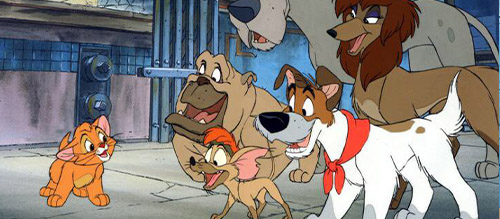5 Reasons Why Oliver and Company (1988) Is an Underrated Animation Classic
3. It’s a Retelling of an Old Classic
The basis of Oliver and Company’s story is that of an orphan being taken in by a streetwise crew of pickpockets, then being adopted into high society; sound familiar at all? That might be because this film is very obviously based on the Charles Dickens classic “Oliver Twist”.
During the film’s reception, and even to this day, many criticise the film for being “too predictable”, dubbing Oliver and Company a poor reflection of Disney’s legacy of classics, yet these critics seem to forget that almost every iconic Disney film is based off a pre-existing fairy tale. Oliver and Company can be easily used to teach younger generations about the classics of literature in a much more child-friendly way, but you can still appreciate the storytelling as you get older and enjoy the film as a story in its own right.
On top of all that, Oliver and Company also proves the timeless nature of Dickens’ stories, as the book which was originally set in Victorian London with an all-human cast can be easily translated into 1980s New York and centred around animal characters.
4. It Has a Diverse Cast
Another reason why it’s surprising that Oliver and Company isn’t better remembered is its established and diverse cast.
New York is well-known for its abundance of different cultural groups all living in one space, so it would make sense that the cast of a film set there would be teeming with diversity. From Billy Joel’s unmistakable Long Island accent to Cheech Marin’s Mexican American accent and beyond, Oliver and Company sounds as diverse as it was behind the scenes.
An important point to make is that none of the characters are stereotypes of a certain culture. It could be argued that Marin’s “Tito” is, but it honestly feels like that character comes from both Tito being a chihuahua and Marin’s usual character role. Another dog in Fagin’s pack is Francis, who is played by Roscoe Lee Browne, a black Shakespearean actor who was famous for refusing roles that were stereotypically black. In Oliver and Company that sentiment is honoured as he plays an English bulldog with a love of the dramatic arts. Each of these characters is well fleshed out and never boiled down to a harmful stereotype, which is important in any film and adds another reason to love Oliver and Company.
5. The Music
Legendary musician Billy Joel plays a key role in Oliver and Company as Oliver’s best friend Dodger, which in of itself promises that music will play a large part in the film.
The title – “Always Once Upon a Time in New York City” – is sung by none other than the legendary Huey Lewis of 80s pop-rock band Huey Lewis and the News (also known for providing the soundtrack to Back to the Future), and the incredibly emotional song lays the stage and sets the tone for what’s to come in Oliver and Company.
Another excellent musical addition is the amazing “Why Should I Worry?”, sung by Billy Joel, which will stick in your head for days with its funky tune and fast-moving pace.
“Streets of Gold” is sung while Fagin’s gang to teach Oliver how to be a pickpocket and, although Rita is voiced mostly by Sheryl Lee Ralph, this song is sung by Ruth Pointer of the iconic Pointer Sisters.
Finally, “Perfect isn’t Easy” gives the feel of an epic Broadway number and is sung by the incredible Bette Midler. Hugely popular pop artist Barry Manilow leant a hand in writing this one.
Each of these songs brings their own flavour to the film’s soundtrack, with a simultaneous presentation of old timey New York and the funky pop of the 1980s.
Recommended for you: Disney Renaissance Movies Ranked
Oliver and Company is iconic. From its setting to story, its cast to its music, this 1980s Walt Disney Animation should be a must-watch on everyone’s childhood watchlists, and remains a phenomenally nostalgic watch for anyone in the mood for some great Disney filmmaking.
But what do you think? What are your favourite parts of Oliver and Company? Let us know in the comments below and be sure to follow The Film Magazine on Facebook and Twitter.




